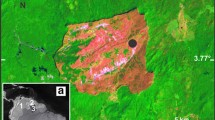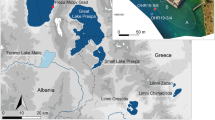Abstract
The historical ecology of the Ahuachapan savanna is reconstructed from a 4.83-m sediment core from Laguna Llano del Espino, Ahuachapan, western El Salvador. Stable carbon isotopes (δ13C), pollen, and charred grass cuticles indicate Holocene grassland dominance from at least ca. 3300 cal yr B.P. to the present. The role of people in the creation and maintenance of Central American savannas is considered in light of the paleoecological record. The data suggest that pre-Columbian inhabitants of western El Salvador suppressed shrub and tree encroachment via frequent burning from ca. 2500 to 500 cal yr. B.P. A substantial increase in woody taxa (Mimosoideae, Urticales) and a decrease in biomass burning are evident in the pollen and charcoal records beginning around the time of the first European contact (ca 500 cal yr B.P.). Evidence for frequent burning and grassland dominance before the arrival of the Europeans, followed by shrub and tree encroachment amid a near absence of fire after contact, suggests that the openness of the Ahuachapan savanna was maintained by the pre-Columbian inhabitants of the Rio Paz Valley throughout the late Holocene.
Similar content being viewed by others
References
Arroyo B. 1995. Early ceramics from El Salvador: the El Carmen site. In: Barnett W.K. and Hoopes J.W. (eds), The Emergence of Pottery: Technology and Innovation in Ancient Societies, Smithsonian Institute Press, Washington, DC, USA, pp. 199–208.
Bauer R.E., Edlund E. and Orvis K. 1991. CALPALYN 2.0. U.C. Berkeley. Department of Geography Palynology Laboratory, Berkeley.
Behling H. and Hooghiemstra H. 1998. Late quaternary paleo-ecology and paleoclimatology from pollen records of the savannas of the Llanos Orientales in Colombia. Palaeogeogr. Palaeocl. Palaeoecol. 139: 251–267.
Brenner M., Curtis J.H., Higuera-Gundy A., Hodell D.A., Jones G.A., Binford M.W. and Dorsey K.T. 1994. Lake Miragoane, Haiti (Caribbean)Gierlowski-Kordesch E. and Kelts K. (eds), Global Geological Record of Lake Basins, vol. 1, Cambridge University Press, Cambridge, England, pp. 401–403.
Brenner M., Leyden B. and Binford M.W. 1990. Recent sedimentary histories of shallow lakes in the Guatemalan savannas. J. Paleolim. 4: 239–252.
Budowski G. 1956. Tropical savannas as a product of repeated forest felling and burning. Turrialba 6: 22–33.
Bush M.B. 2000. Deriving response matrices from Central American modern pollen rain. Quat. Res. 54: 132–143.
Byrne R. and Horn S.P. 1989. Prehistoric agriculture and forest clearance in the Sierra de los Tuxtlas, Veracruz, Mexico. Palynology 13: 181–193.
Colinvaux P. 1997. The history of forests on the isthmus from the ice age to the present. In: Coates A.G. (ed.), Central America: A Natural and Cultural History, Yale University Press, New Haven, pp. 123–136.
Cooke R. 1998. Human settlement of Central America and Northernmost South America (14,000-dy8000 BP). Quat. Int. 49/50: 177–190.
Crutzen P.J. and Andreae M.O. 1990. Biomass burning in the tropics: impact on atmospheric chemistry and biogeochemical cycles. Science 250: 1669–1678.
Daugherty H.E. 1969. Man-induced Ecological Change in El Salvador. PhD thesis, University of California, Los Angeles, CA, USA.
Deevey E.S., Rice D.S., Rice P.M., Vaughan H.H., Brenner M. and Flannery M.S. 1979. Maya urbanism: impact on a tropical karst environment. Science 206: 298–306.
Dull R.A. 2001. El bosque perdido: a cultural-ecological history of Holocene environmental change in western El Salvador. PhD thesis, University of California, Berkeley, CA, USA.
Dull R.A. 2004a. An 8000 cal yr record of vegetation, climate, and human disturbance from the Sierra de Apaneca, El Salvador. Quat. Res. 61: 159–167.
Dull R.A. 2004b. Lessons from the mud, lessons from the Maya: paleoecological records of the TBJ eruption. In: Rose W.I., Bommer J.J., Lopez D. and Carr M.J. (eds), Natural Hazards in El Salvado. Geol. Soc. Am., Boulder, Colorado, USA, Special Paper 375, pp. 237–244.
Dull R.A., Southon J.R. and Sheets P. 2001. Volcanism, ecology and culture: a reassessment of the Volca´n Ilopango TBJ eruption in the southern Maya realm.Lat. Amer. Antiq. 12: 25–44.
Faegri K. and Iverson J. 1989. Textbook of Pollen Analysis. Wiley, Chichester, England, 328 pp.
Fowler W.R. 1988. La población nativa de El Salvador al momento de la conquista españnola. Mesoamérica 15: 79–116.
Hampshire R.J. 1989. El Salvador. In: Campbell D.G. and Hammond H.D. (eds), Floristic Inventory of Tropical Countries: the Status of Plant Systematics, Collections and Vegetation, plus Recommendations for the Future. New York Botanical Garden, New York, pp. 295–298.
Heiri O., Lotter A. and Lemcke G. 2001. Loss on ignition as a method for estimating organic and carbonate content in sediments: reproducibility and comparability of results Paleolim. 25: 101–110.
Hodell D.A., Curtis J.H. and renner M. 1995. Possible role of climate in the collapse of Classic Maya civilization Nature 375: 391–394.
Hodell D.A., Curtis J.H., Jones G.A., Heguera-Gundy A., Brenner M., Binford M.W. and Dorsey K.T. 1991. Reconstruction of Caribbean climate over the past 10,500 years. Nature 352: 790–793.
Horn S.P. 1990. Timing of deglaciation in the Cordillera de Talamanca, Costa Rica. Climate Research 1: 81–83.
Huang Y., Street-Perrott F.A., Metcalfe S.E., Brennner M., Moreland M. and Freeman K.H. 2001. Climate change as the dominant control on glacial-interglacial variations in C3 and C4 plant abundance. Science 293: 1647–1651.
Hutchinson G.E. and Goulden C.E. 1966. The plant microfossils. In: Cowgill U.M., Hutchinson G.E., Racek A.A., Goulden C.E., Patrick R. and Tsukada M. (eds), The History of Laguna de Petenxil. Connecticut Academy of Arts and Sciences, New Haven, CO, USA, pp. 67–73.
Islebe G.A., Hooghiemstra H. and Borg K.v.d. 1995. A cooling event during the Younger Dryas Chron in Costa Rica. Palaeogeogr. Palaeocl. Palaeol. 117: 73–80.
Islebe G.A., Hooghiemstra H., Brenner M. and Curtis J.H. 1996. A Holocene vegetation history from lowland Guatemala. The Holocene 6: 265–271.
Janzen D.H. and Martin P.S. 1982. Neotropical anachronisms: the fruits the Gomphotheresate. Science 215: 19–27.
Lardéy Larin J. 1957. El Salvador: historia de sus pueblos, villas y ciudades. Departamiento Editorial del Ministerio de Cultura, San Salvador, 571 pp.
Lauer W. 1954. Las formas de la vegetacion de El Salvador. Comunicaciones del Instituto Tropical de Investigaciones Cientìficas de la Universidad de El Salvador 3: 41–45.
Leyden B.W. 1987. Man and Climate in the Maya Lowlands. Quat. Res. 28: 407–414.
Leyden B.W., Brenner M., Hodell D.A. and Curtis J.H. 1993. Late Pleistocene climate in the Central American lowlands. In: Swart P.K., Lohmann K.C., McKenzie J. and Savin S. (eds), Climate Change in Continental Isotopic Records. American Geophysical Union, Geophysical Monograph 78, pp. 165–178.
Metcalfe S.E., O'Hara S.L., Caballero M. and Davies S.J. 2000. Records of Late Pleistocene-Holocene climatic change in Mexico - a review. Quat. Sci. Rev. 19: 699–721.
Navarrete C. 1972. El sitio arqueológico de San Nicola´s, Municipio de Ahuachapan, El Salvador. Estudios de Cultura Maya.8: 57–66.
Overpeck J. and Webb R. 2000. Nonglacial rapid climate events: past and future. P. Natl. Acad. Sci. 97: 1335–1338.
Palmer P.G. 1976. Grass cuticles: a new paleoecological tool for East African lake sediments. Can. J. Bot. 54: 1725–1734.
Parsons J.J. 1976. Forest to pasture: development of destruction? Rev. Biol. Trop. 24: 121–138.
Peterson B.J. and Fry B. 1987. Stable isotopes in ecosystem studies. Annu. Rev. Ecol. Syst. 18: 293–320.
Porter-Weaver M. 1993. The Aztecs, the Maya and their Predecessors. Academic Press, San Diego, CA, USA, 567 pp.
Rodbell D.T., Seltzer G.O., Anderson D.M., Abbott M.B., Enfield D.B. and Newman J.H. 1999. An 15,000-year record of El Ni n no-driven alluviation in southwestern Ecuador. Science 283: 516–520.
Roubik D.W. and Moreno P.J.E. 1991. Pollen and Spores of Barro Colorado Island. Monographs in systematic botany, Missouri Botanical Garden, St. Louis, MO, USA, 268 pp.
Saarnak C.F. 2001. A shift from natural to human-driven fire regime: implications for trace-gas emissions. The Holocene 11: 373–376.
Sauer C.O. 1957. Man in the ecology of Tropical America. Proceedings of the Ninth Pacific Science Congress, Bangkok, Thailand, pp. 104–110.
Scott G. 1977. The role of fire in the creation and maintenance of savanna in the montana of Peru. J. Biogeogr. 4: 143–167.
Sharer R.J. 1974. The prehistory of the southeastern Maya periphery. Curr. Anthr. 15: 165–176.
Sheets P.D. 1984. The prehistory of El Salvador: an interpretive summary. In: Lange F.W. and Stone D.Z. (eds), The Archaeology of Lower Central America, New Mexico Press, Albuquerque, NM, USA, pp. 85–112.
Stuiver M., Reimer P.J., Bard E., Beck J.W., Burr G.S., Hughen K.A., Kromer B., McCormac G., Plicht J.v.d. and Spurk M. 1998. INTCAL98 radiocarbon age calibration 24,000-0 cal BP. Radiocarbon 40: 1041–1083.
Stuiver M. and Reimer P. 1993. Extended 14C database and revised Calib 3.0 14C age calibration program. Radiocarbon. 35: 215–230.
Suman D.O. 1983. Agricultural burning in Panama and Central America: burning parameters and the coastal sedimentary record. PhD thesis, University of California, San Diego, CA, USA.
Tsukada M. 1964. Pollen morphology and identification III. modern and fossil tropical pollen with emphasis on Bombacaceae. Pollen et Spores.6: 393–462.
Tsukada M. and Rowley J.R. 1964. Identification of modern and fossil maize pollen. Grana Palynologica.5: 406–412.
Ward P.L. and Jacob K.H. 1971. Microearthquakes in the Ahuachapan geothermal field, El Salvador, Central America. Science 173: 328–330.
Wassen S.H. 1966. An Olmec stone figurine from Ahuachapan, El Salvador. Ethnos 1: 84–89.
Webb S.D. 1997. The great American faunal interchange. In: Coates A.G. (ed.), Central America: A Natural and Cultural History, Yale University Press, New Haven, pp. 97–122.
Weber H.S., Wiesmann G.W., Lorenz W. and ThoméS. 1978. Mapa Geológica de la Republica de El Salvador, San Salvador.
Whitehead D.R. and Langham E.J. 1965. Measurement as a means of identifying fossil maize pollen. B. Torrey Bot. Club.92: 7–20.
Wooller M.J. 2002. Fossil grass cuticles from lacustrine sediments: a review of methods applicable to the analysis of tropical African lake cores. The Holocene 12: 97–105.
Wright H.E., Mann D.H. and Glasser P.H. 1984. Piston corers for peat and lake sediments. Ecology 65: 657–659.
Author information
Authors and Affiliations
Rights and permissions
About this article
Cite this article
Dull, R.A. A Holocene record of Neotropical savanna dynamics from El Salvador. Journal of Paleolimnology 32, 219–231 (2004). https://doi.org/10.1023/B:JOPL.0000042906.46791.9c
Issue Date:
DOI: https://doi.org/10.1023/B:JOPL.0000042906.46791.9c




